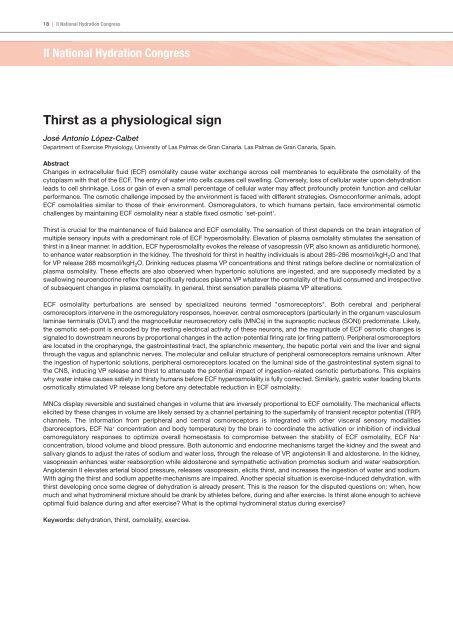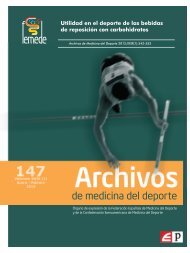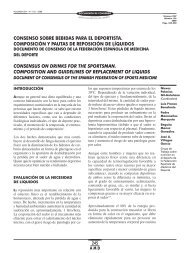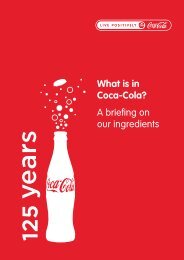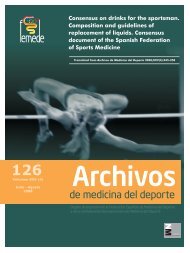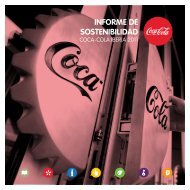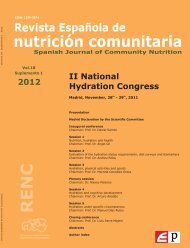II National Hydration Congress - Coca-Cola
II National Hydration Congress - Coca-Cola
II National Hydration Congress - Coca-Cola
You also want an ePaper? Increase the reach of your titles
YUMPU automatically turns print PDFs into web optimized ePapers that Google loves.
18 | <strong>II</strong> <strong>National</strong> <strong>Hydration</strong> <strong>Congress</strong><strong>II</strong> <strong>National</strong> <strong>Hydration</strong> <strong>Congress</strong>Thirst as a physiological signJosé Antonio López-CalbetDepartment of Exercise Physiology, University of Las Palmas de Gran Canaria. Las Palmas de Gran Canaria, Spain.AbstractChanges in extracellular fluid (ECF) osmolality cause water exchange across cell membranes to equilibrate the osmolality of thecytoplasm with that of the ECF. The entry of water into cells causes cell swelling. Conversely, loss of cellular water upon dehydrationleads to cell shrinkage. Loss or gain of even a small percentage of cellular water may affect profoundly protein function and cellularperformance. The osmotic challenge imposed by the environment is faced with different strategies. Osmoconformer animals, adoptECF osmolalities similar to those of their environment. Osmoregulators, to which humans pertain, face environmental osmoticchallenges by maintaining ECF osmolality near a stable fixed osmotic 'set-point'.Thirst is crucial for the maintenance of fluid balance and ECF osmolality. The sensation of thirst depends on the brain integration ofmultiple sensory inputs with a predominant role of ECF hyperosmolality. Elevation of plasma osmolality stimulates the sensation ofthirst in a linear manner. In addition, ECF hyperosmolality evokes the release of vasopressin (VP, also known as antidiuretic hormone),to enhance water reabsorption in the kidney. The threshold for thirst in healthy individuals is about 285-286 mosmol/kgH 2 O and thatfor VP release 288 mosmol/kgH 2 O. Drinking reduces plasma VP concentrations and thirst ratings before decline or normalization ofplasma osmolality. These effects are also observed when hypertonic solutions are ingested, and are supposedly mediated by aswallowing neuroendocrine reflex that specifically reduces plasma VP whatever the osmolality of the fluid consumed and irrespectiveof subsequent changes in plasma osmolality. In general, thirst sensation parallels plasma VP alterations.ECF osmolality perturbations are sensed by specialized neurons termed "osmoreceptors". Both cerebral and peripheralosmoreceptors intervene in the osmoregulatory responses, however, central osmoreceptors (particularly in the organum vasculosumlaminae terminalis (OVLT) and the magnocellular neurosecretory cells (MNCs) in the supraoptic nucleus (SON)) predominate. Likely,the osmotic set-point is encoded by the resting electrical activity of these neurons, and the magnitude of ECF osmotic changes issignaled to downstream neurons by proportional changes in the action-potential firing rate (or firing pattern). Peripheral osmoreceptorsare located in the oropharynge, the gastrointestinal tract, the splanchnic mesentery, the hepatic portal vein and the liver and signalthrough the vagus and splanchnic nerves. The molecular and cellular structure of peripheral osmoreceptors remains unknown. Afterthe ingestion of hypertonic solutions, peripheral osmoreceptors located on the luminal side of the gastrointestinal system signal tothe CNS, inducing VP release and thirst to attenuate the potential impact of ingestion-related osmotic perturbations. This explainswhy water intake causes satiety in thirsty humans before ECF hyperosmolality is fully corrected. Similarly, gastric water loading bluntsosmotically stimulated VP release long before any detectable reduction in ECF osmolality.MNCs display reversible and sustained changes in volume that are inversely proportional to ECF osmolality. The mechanical effectselicited by these changes in volume are likely sensed by a channel pertaining to the superfamily of transient receptor potential (TRP)channels. The information from peripheral and central osmoreceptors is integrated with other visceral sensory modalities(baroreceptors, ECF Na + concentration and body temperature) by the brain to coordinate the activation or inhibition of individualosmoregulatory responses to optimize overall homeostasis to compromise between the stability of ECF osmolality, ECF Na +concentration, blood volume and blood pressure. Both autonomic and endocrine mechanisms target the kidney and the sweat andsalivary glands to adjust the rates of sodium and water loss, through the release of VP, angiotensin <strong>II</strong> and aldosterone. In the kidney,vasopressin enhances water reabsorption while aldosterone and sympathetic activation promotes sodium and water reabsorption.Angiotensin <strong>II</strong> elevates arterial blood pressure, releases vasopressin, elicits thirst, and increases the ingestion of water and sodium.With aging the thirst and sodium appetite mechanisms are impaired. Another special situation is exercise-induced dehydration, withthirst developing once some degree of dehydration is already present. This is the reason for the disputed questions on: when, howmuch and what hydromineral mixture should be drank by athletes before, during and after exercise. Is thirst alone enough to achieveoptimal fluid balance during and after exercise? What is the optimal hydromineral status during exercise?Keywords: dehydration, thirst, osmolality, exercise.


